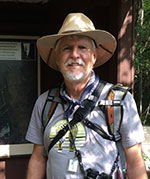
Ecuador | Optional Pre-trip Extension: Nature and Wildlife in the Andes
Quito
Jun 17, 2023
Arrive in Ecuador and a driver will meet you to travel to the hotel. Meals on your own today.
Mindo
Jun 18, 2023
Depart early for Yanacocha Biological Reserve. Clinging to the slopes of Pichincha Volcano at an elevation of approximately 10,000 feet, and comprising 2,371 acres of mostly elfin Polylepis forest, this protected area was established to safeguard the critically endangered and endemic Black-breasted Puffleg. Other high-altitude species include Andean Guan, Rainbow-bearded Thornbill, Golden-breasted and Sapphire-vented Pufflegs, Great Sapphirewing, Sword-billed Hummingbird, Rufous and Tawny Antpittas, Ocellated and Blackish Tapaculos, Black-chested and Scarlet-bellied Mountain-Tanagers, Golden-crowned Tanager, and many more. Enjoy lunch at the reserve. We will also learn about the work of Aves y Conservacion and the community nursery at Alambi. Continue through the Eco-route to Mindo.
Mindo
Jun 19, 2023
Spend the day at Mashpi-Amagusa Reserve, a 320-acre protected area in the Chocó foothills that functions as a critical link between lower subtropical forest and higher montane forest at neighboring Mashpi Lodge. The altitude here ranges from 2,450 to 5,600 feet. The birding is fantastic along this corridor, with many Chocó endemics that are difficult to find elsewhere, such as Rose-faced Parrot, Orange-breasted Fruiteater, Chocó Vireo, Moss-backed Tanager, Black Solitaire, and Indigo Flowerpiercer; a few, like Long-wattled Umbrellabird, require a little luck. Feeders on-site also offer great photo opportunities for hummingbirds and tanagers. Enjoy a boxed lunch during the excursion. Visit Pahuma Orchid Reserve in the afternoon and then return to the lodge
Sangolqui
Jun 20, 2023
Check out and start early with a visit to Refugio Paz de las Aves near Nanegalito (13 miles northeast of Mindo, at 4,590 feet). Angel Paz is the proprietor of this private reserve, and his story is an excellent example of community conservation. Angel was formerly a local logger who transformed his property into a haven for antpittas and Andean Cocks-of-the-rock over a decade ago. His early fame came quickly when he learned how to coax the rare and elusive Giant Antpitta into the open with earthworms. He now has six different species of antpittas staked out on his property: Giant, Yellow-breasted, Ochre-breasted, Chestnut-crowned, Moustached, and Scaled. Other incredible birds on the property include Lyre-tailed Nightjar, Rufous-bellied Nighthawk, Olivaceous Piha, Dark-backed Wood-Quail, Crested and Golden-headed Quetzals, and a fantastic mix of hummingbirds. Return to Quito, en route brief stop at the Middle of the World, then continue to Sangolqui.
Puembo
Jun 21, 2023
Depart for Antisana. The Antisana Ecological Reserve is located on the edge of the Amazon prairie, making it a corridor or nexus between the Ecological Reserve of Cayambe-Coca and the Sumaco Napo-Galeras National Park. Its nearly 300,000 acres are considered a paradise for birdwatchers due to its various ecological zones ranging from páramo (high grasslands and small shrubs where bushes and flowers grow close to the ground) to the lowland rainforest with more than 70 bird species, including the endangered Andean Condor. The snow-capped Antisana Volcano is the fourth highest peak in Ecuador with an elevation of 18,890 feet. We also visit the Antisanilla Reserve and learn about the ongoing spectacled (Andean) bear project. Travel to Puembo to begin the Galapagos program.

 An extraordinary abundance of life inhabits the forests of northwestern Ecuador. Amid subtropical and montane forests, rainforest, páramo, and the eastern and western slopes of the Andes Mountains, you’ll seek out as many of the country’s 1,640-plus species as possible with assistance from your expert guide on this five day pre-trip adventure
An extraordinary abundance of life inhabits the forests of northwestern Ecuador. Amid subtropical and montane forests, rainforest, páramo, and the eastern and western slopes of the Andes Mountains, you’ll seek out as many of the country’s 1,640-plus species as possible with assistance from your expert guide on this five day pre-trip adventure  Jim White
Jim White